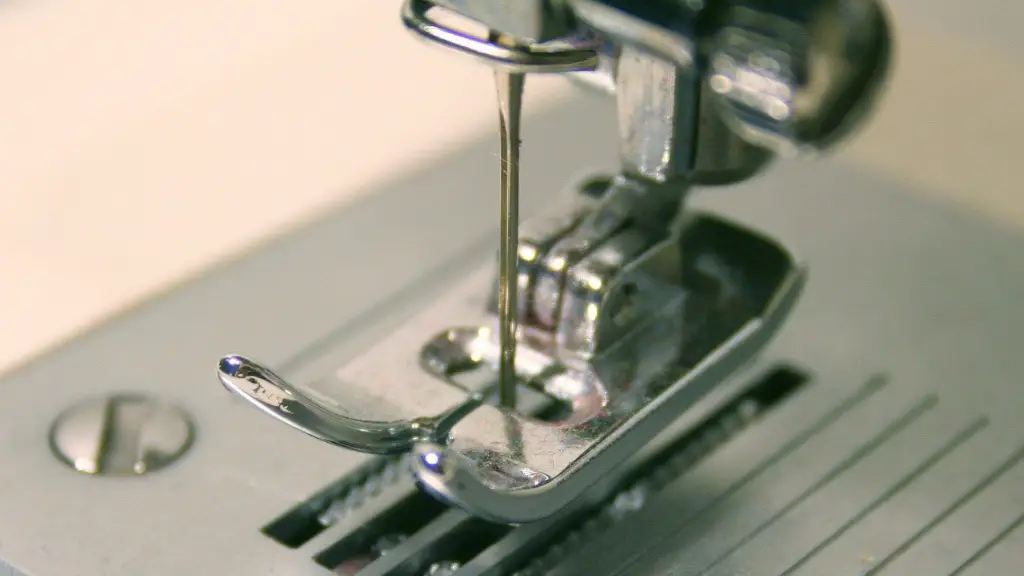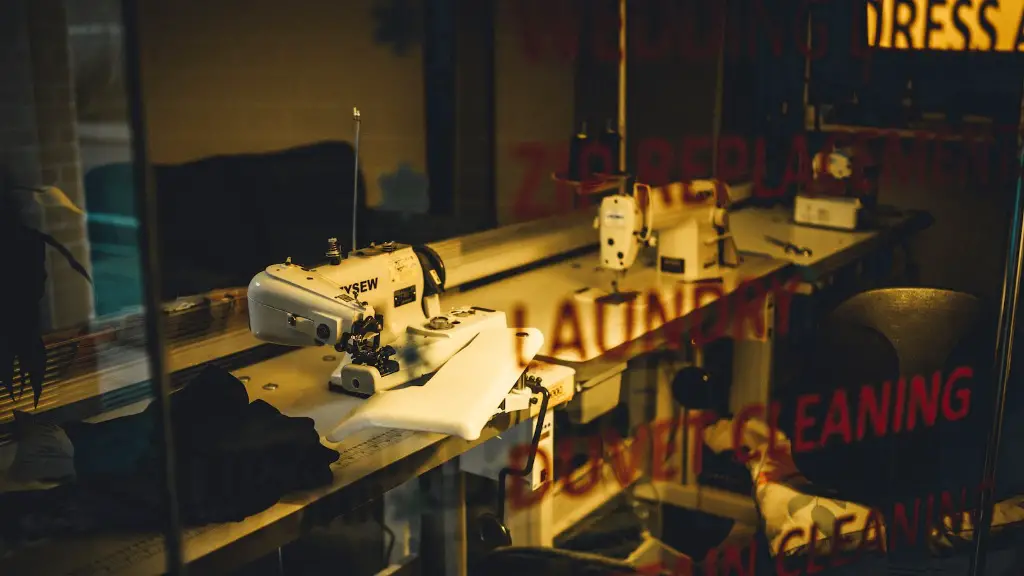Sewing is a skill that can be quite therapeutic for many and is also a key part of fashion and couture. It is a hobby that one might want to take up in order to make clothing, decorations and other items with fabric. This skill has been passed down from generation to generation and it has been a popular form of expression for ages. But what about those who don’t want to invest too much of their finances into getting a sewing machine or suffer from a lack of space? This is where the mini sewing machine comes in.
A mini sewing machine is a great way to get into the craft without taking a huge toll on one’s wallet. It is also light, portable, and can be set-up in almost any space, making it a great alternative to the large, bulky sewing machines. There are several brands and models available in the market and each model provides a unique level of features. Mini sewing machines often have features such as adjustable stitch length, speed settings, and multiple stitch types. They are also particularly useful for the beginner sewers, as their machine will not be taking up too much space and they can learn the basics of sewing in a more efficient and budget-friendly manner.
But, with all this said,do mini sewing machines actually work? The answer is yes. In fact, many people find mini sewing machines to be sufficient for basic sewing needs. They are quite capable of doing occasional repairs, making yard projects like pillows or curtains, and can even be suitable for certain types of garment construction. However, it is important to remember that mini machines are made for amateur sewers and are limited in certain areas. They may not hold up to regular, heavy use and they cannot handle most of the complex sewing patterns one might encounter in more advanced projects. These machines are better suited for those who need a machine to do basic repairs and small projects.
Many sewers can attest to the efficacy of mini sewing machines. Though these machines may seem dinky, they are actually quite sturdy and reliable. Their small size makes it easy for anyone to carry them or quickly pack them away. Owning one will also save a lot of space at home since one does not need to keep a large bulky machine for its one simple function. With the help of these machines even beginners can start sewing basic projects such as simple clothing alterations and small fabric crafts. There are many tips and tricks available online to make the most of the mini machines.
Mini sewing machines have made it easier to get into the craft without spending too much money or needing a dedicated sewing area. These machines can be fun to work with and their small size makes them great for travelling. They are a great option to consider if one wants a machine without committing too much of one’s financial resources and it doesn’t need to have the power and features of expensive models. They are a great way to enter the world of sewing, learn the basics, and get some experience before upgrading to a full-sized model.
Materials for Mini Sewing Machines
One of the biggest factors that determine the capabilities of a mini sewing machine is the material used. Most mini sewing machines are designed to handle lighter-weight fabrics like cotton and chiffon, but there are some that can also sew through heavier fabrics like denim. There are a few models out there that are designed to be multipurpose and can handle both light and heavyweight fabrics, but these typically come with a higher price tag. When shopping for a mini sewing machine, it is important to make sure that the machine can handle the types of materials one plans to work with.
When it comes to bobbin types, mini sewing machines can use either there are plastic or metal ones. Plastic bobbins are cheaper and more common, but they can’t handle heavier fabrics. Metal bobbins are more durable and can support heavier fabrics, but they are more expensive and can be difficult to find. It is important to keep this in mind when shopping for a mini sewing machine, as the wrong bobbin type can cause the machine to malfunction.
No matter the type of bobbin a mini sewing machine requires, it is always a good idea to get pre-wound ones as this helps prevent loose threading or tangles. Additionally, one should always refer to the machine’s manual to see what types of fabrics and bobbins the machine is compatible with.
Additional Accessories
To get the most out of a mini sewing machine, one can also purchase additional accessories such as an extension table, multi-purpose foot and quilting tools. These accessories can greatly expand the capabilities and performance of a mini sewing machine and make it easier for one to work on larger projects. Extension tables, for instance, provide a large work surface and allow one to work on bigger pieces of fabric without strain. Multi-purpose feet can make creating even stitches easier and quilting tools are a great way to finish off one’s projects with perfect stitches. All of these accessories add extra features to the machine and make it more versatile.
So, if one is a beginner and looking for a budget-friendly way to start sewing, a mini sewing machine is a great option. They are economical and can handle some of the most basic sewing projects. Some mini sewing machines may even come with additional accessories, including an extension table, mult-purpose foot and quilting tools. It is important, however, to remember that mini sewing machines are limited in certain areas and are better suited for occasional use. With a mini sewing machine, one can learn the basics of sewing and get some experience before investing in a full-sized model.
How to Troubleshoot Problems with a Mini Sewing Machine
Troubleshooting a mini sewing machine is not as complicated as it may seem. The first thing it to always refer to the machine’s manual and make sure one is familiar with its specifications and features. With some models, the user manual can even have troubleshooting guides that provide step-by-step guidance on how to solve specific problems. It is also a good idea to check if there are any updates available for one’s mini sewing machine. Updates can fix any software problems the machine may have and make it run smoother.
If one is having difficulty threading or getting the machine to sew correctly, it is important to make sure the presser foot is correctly inserted. Presser foots are the parts of a sewing machine that press the fabric against the feed dogs as they move. If they are not correctly attached, the machine will not be able to push the fabric through the needle. Additionally, one should always double-check that the thread tension is properly adjusted. This will ensure that the machine stitches are even and consistent.
Another common problem with mini sewing machines is the presence of loose or tangled threads. This can be caused by threading the machine incorrectly or the thread tension not being set to the right levels. To solve this problem, one should first remove any loose threads and then adjust the thread tension to the proper levels. If this does not work, one can try re-threading the machine or changing the bobbin thread. It is also always a good idea to double-check the machine’s settings to make sure everything is correct.
Care Tips for Mini Sewing Machines
To ensure a mini sewing machine is functioning properly, it is important to take proper care and maintenance of it. This will help prolong its life and guarantee that it will perform adequately for a long time. The machine should be kept in a clean and dry place, since dust and moisture can damage the delicate parts of the machine. It is also important to lubricate the machine every few months to prevent rust and corrosion. Additionally, one should clean the machine regularly and make sure all the parts are in good condition.
When not in use, it is important to store the mini sewing machine in a safe place. It is best to store it upright in its box or a storage bag, as this will prevent dust and dirt from getting inside it and damaging the delicate components. It is also important to unplug the machine when cleaning it or when not using it. This will ensure that the machine is not running on empty and this will reduce the chances of an electrical short circuit.
Lastly, it is important to remember to always keep the machine away from children and pets. It is also important to refer to the machine’s manual when changing any settings or trying new stitches. This will reduce the chances of any accidents or mistakes. Taking proper care of one’s mini sewing machine will ensure that it is functioning perfectly for a long time.
Pros and Cons of Using a Mini Sewing Machine
In conclusion, mini sewing machines are great for those considering to learn the basics of sewing. They are budget-friendly, portable and can handle basic sewing needs. However, they are limited in certain areas and are not suitable for more advanced projects. It is important to remember that they are made for beginner sewers and regular, heavy use is not recommended.
One of the main pros of using a mini sewing machine is its low price. This makes it an attractive option for those who want to learn the basics of sewing without breaking the bank. Additionally, these machines are light and small, making them easy to store and take with one on travels. They are also quite capable of sewing through lighter-weight fabrics like cotton and chiffon.
On the other hand, one of the main cons of buying a mini sewing machine is that they usually can’t handle heavier fabrics like denim or corduroy. Additionally, they are limited in terms of features and accessories, so most complex sewing patterns cannot be done with these machines. Lastly, they may not hold up to regular, heavy use and may need to be replaced or upgraded after some time.




